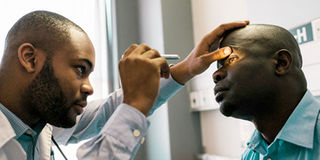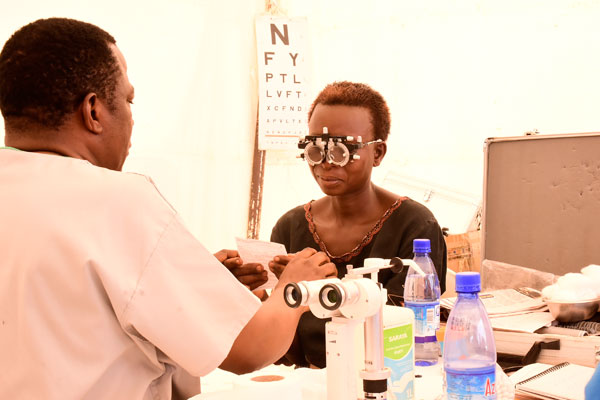Prime
Refractive errors: When you cannot see clearly

If you are 40 or older, you should get your eyes checked every one to two years.
What you need to know:
- A number of people have problems with their eye sight but many do not know that they could be seeing better, the reason why eye exams are important.
Sandra Nakijjoba is addicted to her phone and tablet. The gadgets are her lifelines in a world where all information within her sphere travels through social media. The bright screen of her tablet, as she reads an e-book, is the last thing she looks at before she falls asleep.
“I am usually up by 5.20am, and I spend the next 40 minutes lying in bed, checking my WhatsApp and scrolling through my Facebook and Twitter feeds. If I have time, I catch up with a page or two of the e-book I am reading,” she says.
This has been her routine for the past six years, and slowly, she is now waking up to a new problem.
“I cannot say precisely when it started, but I am realising that my vision is becoming unclear. I cannot bear to look at the morning sky as I drive to work, so I always drive with the sun visor down, even when there is no sun. Sometimes, I get disoriented. I cannot clearly distinguish things at a distance,” she says.
Nakijjoba says her visual challenges are worsened by the fact that she has to look at her computer all day.
Screen time
Although statistics are hard to come by, Nakijjoba is part of a growing number of people suffering from refractive error brought on by long periods of screen time.
Refractive error means that the shape of the eye does not bend light correctly, and as a result, one sees a blurred image. Dr Gladys Atto, an ophthalmologist with Moroto Regional Referral Hospital, says refractive errors are common nowadays.
“The issues arising from prolonged time on phones and looking at computer screens are risk factors for getting myopia or what people in lay language call nearsightedness. Refractive error is the second leading cause of blindness in the world. Many people have it at a level that may not interfere with their day-to-day work, but it is not something that should be ignored,” Dr Atto says.
ALSO READ: Contact lenses are convenient but require care
Dr Atto adds that refractive error covers myopia (nearsightedness), hyperopia (farsightedness, presbyopia (loss of near vision with age, which usually starts at 40 years). A person with presbyopia can only read by putting the phone or book a distance away from their eyes.
Why the growing concern?
Mercy Ndinyo, an optometrist at Lapaire Uganda, an eye-care organisation, says the Covid-19 induced lockdowns, that forced people to work from home, may have contributed to an increase in the problem.
“If the eyes focus for a long time on near objects, such as phones and computer screens, the eyeballs will become elongated and this prevents the eye from bending light, as it should. Prolonged exposure to blue light from computer screens can be linked to blurry vision, eyestrain, and dry eye. Since the lockdown was lifted, we have seen an increased demand for anti-reflective glasses in our shops,” Ndinyo says.
According to the World Health Organisation (WHO), the number of people globally with refractive errors has been estimated at one to two billion. The rates vary between regions of the world, with about 25 percent of Europeans and 80 percent of Asians affected.
Minimising damage
Ndinyo advises those who must work at their computer all day to consider acquiring anti-glare screens.
“What is critical here, with a phone or computer, is the viewing distance. For instance, if you read a book from 20 centimetres away, all day, you will probably develop myopia pretty soon. You can protect your eyes by reducing the glare from bright lights. Alternatively, you can turn on the night light, eye care or eye comfort shield feature on your gadgets to use warm colours and limit the blue light emitted,” she says.
However, the ultimate protection is to make a conscious effort to reduce daily screen time and take frequent breaks to rest the eyes.
“Follow the 20-20-20 rule when using digital devices. Take a 20 second break every 20 minutes and look at something at least 20 feet away. Also make a conscious effort to blink frequently as that is one of the natural ways to refresh our eyes,” Ndinyo says.
How to correct the damage
To minimise the damage to her eyes, Nakijjoba acquired tinted reading glasses to use while working on her computer and reading her-e-books on her tablet. However, Dr Atto advises that people with refractive errors need to see an eye doctor.
“You need the error corrected. Eye checkups are mandatory for adults. You may see the world in a blurred way and believe everyone else sees it that way. I have known some who come in (for treatment) and when they are given glasses, they exclaim that, ‘You mean the world is this clear,’” she says.
Dr Atto adds that children should also have regular eye checks, even before they start school. Nowadays, there are a number of ways to correct refractive errors.
“For those who choose eye glasses, they must be prescribed in the hospital. If you just go to an eye care shop and request for glasses, it will be like self-medication because the work of the technicians in the shop is just to give you glasses but they may not explain why you are getting them, or how the problem can be prevented,” she says.
Alternative measures include use of contact lenses, which provide a wider field of vision, and laser surgery to permanently change the shape of the cornea.
Note
Refractive errors cannot be prevented, but they can be diagnosed by an eye examination and treated with corrective glasses, contact lenses or refractive surgery. If corrected in time and by eye-care professionals, they do not impede the full development of good visual function. Correction is provided in different forms according to the defect, the age of the person and requirements in terms of work of activity performed.
[email protected]





